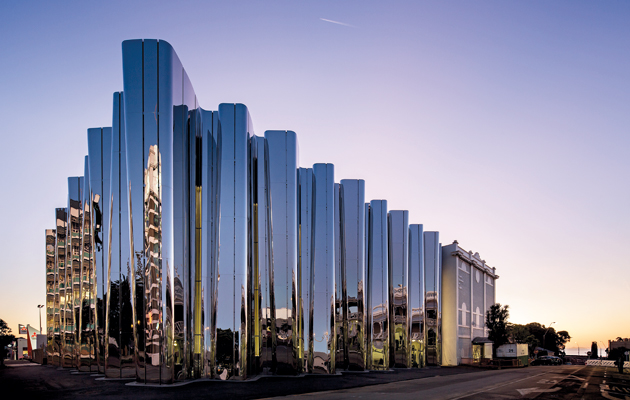|
|
||
|
It’s all about the facade at this New Zealand art gallery, but that doesn’t make it superficial. Its value lies in what it reflects – and what it conceals, says Edwin Heathcote Art,” wrote Len Lye, “is the most valuable and least useful of all things ever made.” Bearing that in mind, how might you make a museum dedicated to the artist? By making it valuable but useless, or perhaps the opposite, embodying function but eschewing value: a more utilitarian thing? An answer stands on a street corner in New Plymouth, a town on New Zealand’s North Island that’s not very near anything but luxuriates in money from a booming energy industry. It is a wobbly crazy mirror, a curtain of polished stainless steel that reveals nothing but reflects the town’s colonial-era architecture back to itself – along with the smattering of tourists snapping selfies in its seductive surface. Mirrored walls might seem a bit of a cop-out, a denial of presence, but looking at the art inside it seems a considered, intelligent and elegant response. Len Lye was a fascinating figure. Born in Christchurch, he worked his way across the Pacific on a steamer to London between the wars. He became involved in a remarkable array of media, from photograms (exposures directly onto photographic paper), painting, public information and sculpture. Among his most memorable works was a series of films for the GPO’s film unit – public-service commercials in which the Post Office effectively subsidised avant-garde film – and Kill or Be Killed, his film for the forces explaining how to cope with hand-to-hand fighting, the directness of which shocked many at the time.
The internal street is flanked by a curtain of exposed concrete After London he moved to New York, where his practice embraced animated scratch films synchronised with hard bop soundtracks and, increasingly, kinetic sculptures. It is this latter medium with which he has become most associated – a huge Wind Wand bows gently like a reed on the coast a short walk from the Centre. Another example seems to give a clue to its facade – inside, a huge ribbon of steel is curved into a loop and wobbles along a base propelled by invisibly moving electro-magnets and, on occasion, strikes a suspended ball, making a steely bong. Funny, intriguing and mesmeric, this is a work about distortion and anticipation just as, in a way, the wobbly facade is a theatrical gesture designed to pique interest, a sculpture in which the kinetics is replaced by the ever-changing reflections of sky and traffic. Auckland architect Patterson Associates has done a fine job in creating a striking corner for this central site, hinting at something strange in surroundings that appear to be transported from an English seaside promenade. The Govett-Brewster Art Gallery, of which the Centre is now a part, is housed in a 1918 cinema building, once slated for demolition but saved in the 1970s by popular outcry. There’s a hint of LA in the combination of white-painted picture house, mirrored museum, slightly straggly palm trees and deep blue sky, dazzlingly reflected in the folds of the stainless steel. Old and new sit surprisingly comfortably together, and are similar in height, the street line having been taken up.
The gallery occupies a corner plot in the historic town centre Upon entering, what appears outside as a dazzling, wavy mirror turns out to be a striking curtain of concrete. Slots in the joins between pleats allow light in, an effect that has been slightly spoiled by bright recessed lights in the high ceiling. This space, with its wonderful undulating concrete walls, might have been a central space for installations; instead it has been used as a lobby or internal street, which is sensible, but does seem to squander a theatrical volume. The galleries themselves are fine, if not memorable, doing a good job of accommodating the huge discrepancies in scale between Lye’s works, from massive steel sculptures to small sketches and sparkly films. The art itself is buzzing with ideas – it becomes almost a relief that the architecture leaves you alone. A corner cafe on the other side of the gallery is cool but understated, with nothing at all to do with the wobbly elevations. The lack of a substantial shop adds to a hermetic effect of immersion in the artist’s oeuvre. Next door, the old cinema has been carefully upgraded, the original rake of the seating still forming an internal amphitheatre and the strange level changes a little rationalised. There are some interesting collisions of plan-form, leading to odd corners and awkward angles that, in fact, don’t detract at all. Ultimately, this is a building defined by its facade – the worst kind of superficiality, you could argue. Actually, I’d suggest it is a terrifically effective wrapper for a relatively unassuming institution. This is more a building about the city than about its contents, creating an arrestingly dynamic corner and a monument to the country’s most interesting modern artist. It truly does something for the streetscape, creating a kind of public space merely in the depth of the town’s own reflection. It is a building about surface – but that membrane is so seductive it succeeds beyond anything you might imagine. |
Words Edwin Heathcote
Above: The mirrored facade reflects the town’s colonial-era architecture back to itself |
|
|
||




















